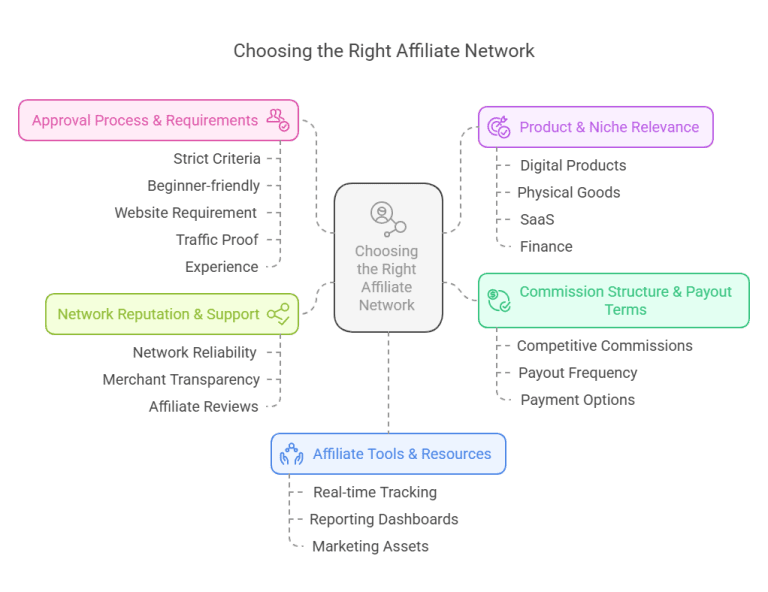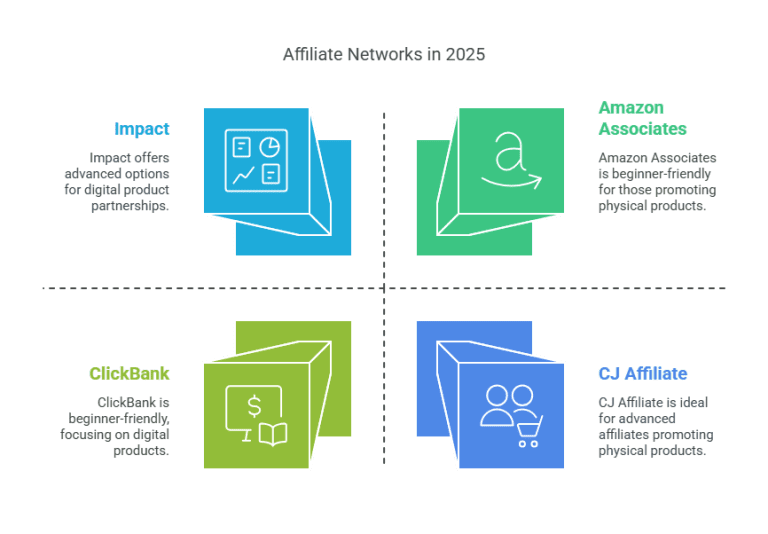Introduction
Affiliate networks play a crucial role in online marketing by serving as intermediaries between brands and affiliate marketers. Instead of partnering with individual brands, affiliates can access multiple offers through a single platform.
This guide will explain what affiliate networks are, how they work, and how to choose the right one to maximize your earnings in 2025.
Key Takeaways
Affiliate networks act as centralized platforms that connect affiliates with multiple brands, offering tracking, payouts, and access to a variety of offers.
Choosing the right network depends on your niche, experience level, payout preferences, and traffic strategy.
Beginner-friendly networks like ShareASale, Awin, and Amazon Associates are ideal for new affiliates starting with blogs, social media, or YouTube.
High-earning networks like ClickBank, CJ Affiliate, and Impact offer larger payouts, advanced tools, and premium brand partnerships—best for more established marketers.
Affiliate networks differ from affiliate programs by offering access to multiple merchants, centralized tracking, and easier income scaling.
Success with affiliate networks comes from matching the right offers to your audience, using strong content, and tracking performance consistently.

🧠 What Is an Affiliate Network?
An affiliate network is a centralized platform that connects brands (also called merchants) with affiliate marketers who want to promote their products. It acts as the middleman that simplifies how affiliates discover, apply to, and manage affiliate offers across multiple companies—all from a single dashboard.
Instead of reaching out to brands one-by-one, affiliates join a network to get instant access to hundreds or even thousands of offers in a specific niche or across industries. The network provides tracking tools, real-time reporting, and handles payments—so affiliates can focus on driving traffic and earning commissions.
Affiliate networks streamline the entire affiliate marketing process and are ideal for both beginners and experienced marketers who want to scale fast.
How Affiliate Networks Simplify the Process:
- They offer ready-to-promote offers across niches like fashion, fitness, software, finance, and more.
- They provide performance tracking tools so you can monitor clicks, sales, and earnings.
- They centralize payouts, meaning you get one payment even if you promote multiple merchants.
- They often include marketing resources like banners, email templates, and promotional copy to help affiliates convert better.
Example:
If you’re a YouTuber focused on productivity tools, you could join an affiliate network like Impact or CJ Affiliate and access dozens of relevant software offers—without having to build individual brand partnerships yourself.
⚙️ How Do Affiliate Networks Work?
Affiliate networks operate as digital marketplaces where affiliates and brands connect, track performance, and get paid. They automate and centralize the back-end of affiliate marketing so you can focus on content creation and conversions instead of chasing down payments or managing brand relationships.
Here’s how the process typically works from start to finish:
- Brands Join the Network Merchants list their products or services on the affiliate network, set their commission structures, and define terms—like cookie durations, payout models (CPS, CPA, etc.), and any approval requirements.
- Affiliates Sign Up and Apply to Programs As an affiliate, you register with the network and browse available offers. Depending on the brand, you may need to apply and be approved before you can promote their products.
- You Receive Unique Tracking Links Once approved, you’ll get access to affiliate links. These URLs contain unique identifiers that track which sales or leads came from your content—whether it’s a blog, video, email, or social media post.
- Users Click and Take Action When someone clicks your link and takes a qualifying action (like a purchase, sign-up, or download), the network records it. The action is tied to your account using cookies and tracking pixels.
- The Network Processes the Commission After the action is verified and the return period (if any) has passed, your commission is credited. The network bundles earnings from multiple brands and pays you on a fixed schedule—weekly, biweekly, or monthly.
Why This Matters:
Affiliate networks remove the friction. You don’t need to:
- Manage multiple dashboards for different brands.
- Worry about delayed or missed payments.
- Track performance manually.
Everything is handled for you—making it easier to scale your affiliate income and focus on strategy, content, and traffic generation.

🧩 How to Choose the Right Affiliate Network
Choosing the right affiliate network isn’t about picking the biggest name—it’s about finding the best fit for your niche, monetization goals, and content strategy. With so many options out there, selecting the right one can directly impact how much you earn and how easy it is to scale.
Here’s how to evaluate and choose the best affiliate network in 2025:
1. Commission Structure & Payout Terms
Not all commission models are created equal. Look closely at how and when you get paid.
- CPS (Cost Per Sale): You earn a % of each sale.
- CPA (Cost Per Action): You earn for actions like sign-ups or free trials.
- CPC (Cost Per Click): You get paid per click—great for high-traffic, low-conversion niches.
- Recurring Commissions: Perfect for SaaS or subscription products.
- Hybrid Models: A mix of sales, clicks, and actions.
Also check:
- Payout frequency – Weekly, bi-weekly, or monthly?
- Minimum payout threshold – Can you cash out at $10, or is it $100?
Payment methods – Do they offer PayPal, bank deposit, crypto, or wire transfers?
2. Product & Niche Relevance
Relevance is everything. The closer the products match your audience’s needs, the higher your conversions.
- Are the offers aligned with your content?
- Are there products/services your audience already wants?
- Does the network specialize in your niche? (e.g., digital products, finance, SaaS, fitness)
Pro Tip: Browse the merchant list before signing up. You don’t want to join a network just to find it lacks strong offers in your space.
3. Network Reputation & Support
Before you trust any network with your time or traffic, vet their reputation.
- Check affiliate reviews on blogs, forums, and Reddit.
- Look for signs of delayed payments or unresponsive support.
- See if the platform is transparent about terms, tracking, and payout policies.
Top-tier networks also offer dedicated affiliate managers—a huge plus for growing your earnings faster.
4. Affiliate Tools & Resources
Smart tools can mean smarter earnings. Look for:
- Real-time dashboards that show traffic, clicks, and conversions.
- Pre-made creatives like banners, email templates, swipe copy.
- Deep linking tools for linking directly to specific product pages.
- A/B test features or tracking pixels for custom data insights.
5. Approval Process & Entry Barriers
Some networks are beginner-friendly, others require a more polished setup.
Ask:
- Do you need a website or active social following?
- Is there a traffic minimum?
- How long does the approval process take?
Tip: Start with beginner-friendly platforms like ShareASale or Awin if you’re just starting out.
The “right” network depends on your audience, niche, and monetization goals. Don’t chase big names—chase fit, support, and long-term potential.

🏆 Top Affiliate Networks in 2025
In 2025, affiliate marketers have access to a growing number of high-quality networks, each catering to different experience levels, niches, and earning strategies. Choosing the right one depends on your content platform, target audience, and how you want to monetize your traffic.
Here’s a refined list of the most trusted and effective affiliate networks in 2025, based on credibility, usability, and performance potential.
1. CJ Affiliate (formerly Commission Junction)
Best for: Experienced marketers with a website or email list.
CJ Affiliate is one of the largest and most established affiliate networks globally. It offers access to premium merchants across categories like retail, finance, travel, and tech.
- Trusted by global brands.
- Real-time performance tracking and deep linking tools.
- Requires an established content platform for approval.
Ideal if you’re scaling and want to partner with high-volume merchants.
2. ShareASale
Best for: Beginners ready to promote a wide range of products.
ShareASale is known for its ease of use and low entry barriers. With thousands of merchants in niches like fashion, home, wellness, and business tools, it’s a great starting point.
- Fast, beginner-friendly approval process.
- Over 4,500 merchant programs.
- Clean dashboard with essential tracking features.
Great for bloggers, influencers, or new affiliate marketers building their first income stream.
3. Amazon Associates
Best for: Content creators promoting physical products.
Amazon’s affiliate program is one of the most recognizable in the world. It allows you to earn commissions on any qualifying purchase made within 24 hours of a click.
- Huge product catalog in every category imaginable.
- Easy integration with blogs, YouTube, and social media.
- Lower commission rates, but high volume potential.
Perfect if you’re reviewing or recommending products to a general audience.
4. ClickBank
Best for: Digital product promoters and course marketers.
ClickBank specializes in eBooks, software, memberships, and info products. It’s known for offering high commissions—often 50% or more—and many products with recurring payouts.
- Fast approval, often with instant access to promote.
- Transparent performance metrics.
- Ideal for email marketing, content marketing, or YouTube reviews.
Best suited for affiliates looking to maximize earnings per sale.
5. Awin
Best for: Affiliates promoting eCommerce, travel, and lifestyle products.
Awin is a global affiliate network offering access to brands like Etsy, Booking.com, and AliExpress. It’s easy to join and a solid choice for affiliates focused on niche content or consumer products.
- Low entry barriers.
- Broad mix of digital and physical product offers.
- Beginner-friendly onboarding process.
Great for creators who want to start monetizing quickly with well-known global brands.
⚠️ Other Notable Mentions
While not heavily covered in your internal docs, networks like Rakuten Advertising and Impact are also respected. Rakuten is known for brand partnerships in fashion and electronics, while Impact is popular among affiliates focused on custom deals, recurring commissions, and brand collaborations. If you want to explore those platforms, verify the latest features on their official sites.
🧭 Quick Recommendation Guide:
Goal | Start With |
Beginner with no website | ShareASale, Awin |
Content creator (YouTube/blog) | Amazon Associates, ClickBank |
Scaling with a niche audience | CJ Affiliate, ClickBank |
Promoting digital info products | ClickBank |
Working with global eCommerce | Awin, Rakuten |

🔍 Affiliate Networks vs. Affiliate Programs: What’s the Difference?
At first glance, “affiliate network” and “affiliate program” might seem interchangeable—but they serve different roles in the affiliate marketing ecosystem. Understanding the distinction helps you decide where to start and how to scale your efforts effectively.
🏢 What Is an Affiliate Network?
An affiliate network is a third-party platform that connects multiple brands (also called merchants) with affiliate marketers. The network handles:
- Centralized offer discovery across various niches.
- Tracking, reporting, and link generation.
- Commission payments for multiple brands in one payout.
Think of it as a digital marketplace for affiliate offers.
Example: Networks like CJ Affiliate, ShareASale, or Awin offer access to hundreds (or thousands) of merchants—so you can apply, track, and get paid all in one place.
🧩 What Is an Affiliate Program?
An affiliate program is a direct partnership between a brand and its affiliates—without an external network in the middle. The brand manages its own system for:
- Creating tracking links.
- Handling commissions and reporting.
- Managing support and affiliate communication.
These are typically found on the brand’s website under “Affiliate” or “Partners.”
Example: Amazon Associates and Shopify’s affiliate program are both standalone programs. You apply directly through their sites and manage everything within their ecosystem.
🔄 Key Differences at a Glance:
Feature | Affiliate Network | Affiliate Program |
Access to Multiple Brands | ✅ Yes | ❌ No – One brand only |
Centralized Payments | ✅ Yes – All in one place | ❌ No – Paid by individual brands |
Setup Complexity | 🔄 Moderate – One platform, many offers | ✅ Simple for single-brand focus |
Support & Resources | ✅ Often includes training & creatives | 🔄 Varies by brand |
Best For | Scaling, multi-niche marketers | Brand-focused content creators |
🧠 Which One Should You Use?
- If you’re just starting out and want options → Start with an affiliate network.
- If you’re focused on one product or platform → Go direct with an affiliate program.
- Many top affiliates use both—networks for variety, programs for niche depth or higher payouts.

❓FAQs About Affiliate Networks
What is the best affiliate network for beginners?
If you’re new, ShareASale, Awin, and Amazon Associates are excellent starting points. They have low entry barriers, easy onboarding, and a wide selection of products to promote—making them perfect for creators building early momentum.
Do affiliate networks cost money to join?
Most affiliate networks are completely free to join. You don’t pay to access offers. However, some programs may require you to meet specific criteria (such as having a website, traffic, or a niche audience) before you’re approved.
How do affiliate networks make money?
Networks earn a small percentage from each transaction—usually from the brand side, not the affiliate. This incentivizes the network to support both sides and maintain a healthy ecosystem of merchants and marketers.
Which networks offer the highest commissions?
If you’re looking for high payouts, start with:
- ClickBank – Often 50%+ on digital products and courses.
- Impact – Offers custom deals and recurring commissions.
- CJ Affiliate – Great for higher-ticket or brand-name offers.
Just remember: high commission doesn’t always equal high profit—conversion rates and audience fit matter too.
Are affiliate networks better than joining individual programs?
Not necessarily—it depends on your strategy. Networks save time and give you variety, while individual programs (like Shopify’s or ConvertKit’s) often offer better support or higher commissions. Many top affiliates use both to diversify and optimize income streams.
Can I use multiple affiliate networks at once?
Absolutely. There’s no limit to how many you can join. Just be sure to:
- Stay organized with your links and reporting.
- Follow each network’s terms of service.
- Focus on promoting offers that genuinely align with your content.

🧾 Conclusion: Choosing the Right Affiliate Network Starts Here
Affiliate networks play a crucial role in helping both new and experienced marketers earn online. They simplify the process of finding, promoting, and profiting from quality offers—while handling all the tracking, reporting, and payouts behind the scenes.
If you’re just getting started, platforms like ShareASale, Awin, or Amazon Associates offer an easy way in. If you’re more experienced or ready to scale, CJ Affiliate, ClickBank, or Impact provide higher-ticket opportunities and advanced tools.
The best network for you comes down to your:
- Niche
- Experience level
- Traffic strategy
- Preferred commission structure
By choosing the right platform, you’re not just signing up—you’re setting the foundation for long-term affiliate income.
📌 Next Step: Explore our Affiliate Marketing Platforms Guide for side-by-side comparisons of top tools, payout structures, and traffic strategies.
Next Step: Ready to start promoting your offers?
Learn the best platforms to launch your affiliate links in this guide to affiliate marketing platforms.

1 Comment
Affiliate Marketing Platforms: Best Places to Start in 2025 - Ismel Guerrero. · April 13, 2025 at 11:00 pm
[…] Check out how affiliate networks work and where to find offers. […]